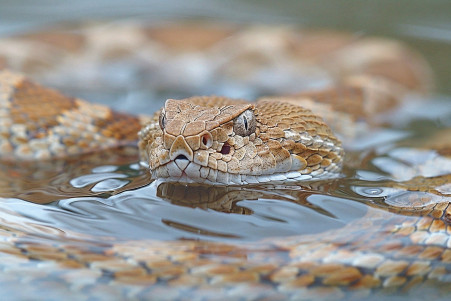Can Snails Swim? Unveiling the Aquatic Abilities of Gastropods
27 May 2024 • Updated 27 May 2024

Can snails swim, or are these mollusks limited to moving through their environment using their muscular foot to crawl? While snails aren’t exactly famous for their swimming skills, many snail species can swim for long distances by using their foot to create a wave-like motion.
This article explores scientific observations and experiments that have revealed the surprising swimming abilities of snails. Get ready to learn how different snails have used swimming to adapt to life in water and on land. This article will change the way you think about snails and their swimming skills and help you understand the many ways snails have evolved to use swimming to survive. In learning about snails’ swimming abilities, you’ll come to see these creatures in a whole new light.
Can Snails Swim?
Aquatic Adaptations: How Do Snails Swim?
Snails have adapted to their environments with their muscular foot, which is covered in a slimy mucus that helps them move and protects them from injury. The foot moves in a wave-like pattern to help the snail swim.
In addition to the general adaptations that help snails swim, some marine snails, such as heteropods, have evolved special visual adaptations to help them see in the ocean's dark "twilight zone". As the DEEPEND Consortium explains, heteropods have a tubular retina that scans the environment in 90-degree arcs, which the snail then pieces together in its mind to form a complete picture. This shape also helps them avoid being seen as a silhouette by potential predators.
The neurotransmitters dopamine and serotonin help regulate the speed and strength of a snail's swimming behavior. These adaptations help illustrate the many ways that different snail species have evolved to become successful swimmers, living in the water as well as on land.
Why Swimming Is an Advantage
Swimming snails have several advantages over non-swimming snails in aquatic ecosystems. A study in the journal Knowledge and Management of Aquatic Ecosystems found that swimming enables snails to better access resources like food and habitats and escape predators. In fact, some swimming snail species are so important that they help improve water quality by promoting the growth of submerged plants and reducing algal biomass.
The presence of swimming snails and submerged plants can lead to a significant increase in water clarity and a decrease in nutrient levels in aquatic ecosystems. The study showed that the presence of both snails and plants led to lower nutrient and planktonic algae concentrations than the presence of either alone. Swimming also enables snails to disperse and colonize new habitats, which can help them survive and thrive.
Aquatic Snail Species: Swimming Pros
According to the Wikipedia page on freshwater snails, freshwater snails in the Neritimorpha group, which includes the Neritiliidae and Neritidae families, are good swimmers. The Acochlidiacea order also has several shell-less freshwater snail species that are good swimmers.
In the open ocean, marine snails like sea butterflies (pteropods) and heteropods have developed different swimming styles and adaptations, as outlined in the article on marine snail swimming styles. The great pond snail (Lymnaea stagnalis) is a large freshwater snail that is a strong swimmer and is often kept in aquariums, according to the Wikipedia page on Lymnaea stagnalis.
Notably, snails with wing-shaped shells, like sea butterflies, are faster and more agile swimmers than those with coiled shells, according to the study on marine snail swimming styles.
Crawling vs. Swimming: The Snail's Locomotion Conundrum
Terrestrial snails crawl by undulating their foot and creating muscular waves that move from the tail to the head, propelling them forward. According to a study in the Journal of Experimental Biology, this crawling mechanism is enabled by pedal waves, which are created by the foot's muscle contractions and relaxations, and the mucus layer, which provides the necessary friction and thrust.
On the other hand, aquatic snails also undulate their foot to create muscular waves, but they use this swimming motion to move through the water. As explained on the Molluscs.at website, freshwater snails such as Lymnaea use a combination of muscular waves and ciliary gliding to swim faster.
Interestingly, a study of the crawling mechanisms of aquatic and terrestrial gastropods determined that the locomotor apparatus is the same in both snails, and the difference between crawling and swimming is an adaptation to their environment. Furthermore, the speed and vigor of crawling and swimming in different snail species can be modulated by the same neurotransmitters, including dopamine and serotonin.
Conclusion: The Amazing Aquatic Locomotion of Snails
In addition to the ability to swim, freshwater snails can also "walk" on the surface of the water due to the buoyancy of their shells, according to Can a Snail Swim? | Pets on Mom.com. While not technically swimming, this is another example of the unique ways snails move through water.
In contrast, many marine snails have no shells or very small shells and use their foot to float or swim. For example, the sea hare, a close relative of snails, has flaps on its foot that it uses to swim, according to the same article.
Even more surprisingly, some snails can jump, with Can a Snail Swim? | Pets on Mom.com noting that common garden snails can leave a "stuttered slime trail" when moving across a dry surface, making it look like they're jumping.
Learning about the swimming abilities of snails and the many species that have developed them underscores the resilience and adaptability of these creatures, challenging stereotypes and revealing the many talents of these often-overlooked gastropods.


